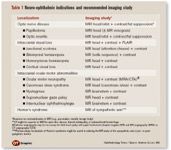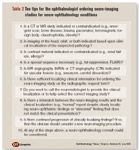Article
Ten tips for the ophthalmologist in ordering neuro-imaging
MRI is in general superior to CT for neuro-ophthalmic indications. A CT study, however, might be useful [under certain circumstances].

The roles of the comprehensive ophthalmologist are 1) localize the neuro-ophthalmic problem; 2) select the most appropriate imaging study; and 3) provide sufficient clinical information to the neuroradiologist to allow the best interpretation of the films. If the ophthalmologist is unable or unwilling to complete these tasks, then referral to a neuro-ophthalmologist is a reasonable alternative.


The neuroradiologist should be called, however, if there is any question on the type of study that would best suit the clinical needs.
Timely and adequate communication between the ordering ophthalmologist and the interpreting neuroradiologist is the most important message of this brief report.
Andrew G. Lee, MD, is professor of ophthalmology, neurology, and neurosurgery, The H. Stanley Thompson Neuro-ophthalmology Clinic, Department of Ophthalmology, University of Iowa Hospitals and Clinics, Iowa City. He can be reach by phone at 319/384-7372, fax at 319/353-7996, or by e-mail: andrew-lee@uiowa.edu
.
Newsletter
Don’t miss out—get Ophthalmology Times updates on the latest clinical advancements and expert interviews, straight to your inbox.




